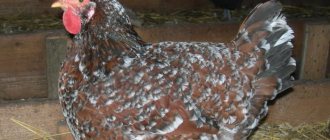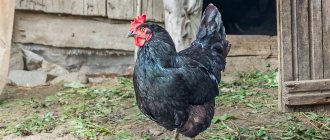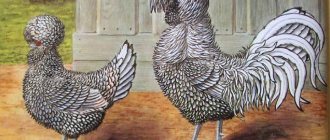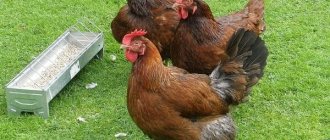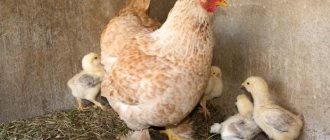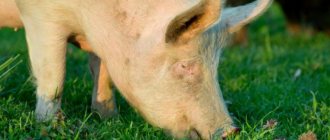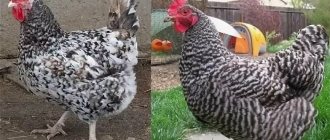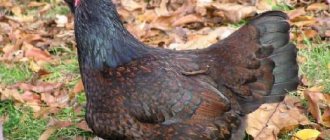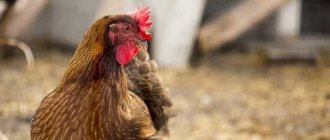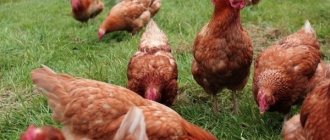The world knows about 700 individual breeds and varieties of chickens: for industrial breeding, for homestead economic activity. Some birds are famous for their rapid weight gain, others for their amazing egg production.
The Chinese silky chicken breed (during the Tang Dynasty they were called “snats”), in addition to excellent meat, excellent dietary characteristics of eggs, and the most delicate fluff, amazes with its truly extraordinary appearance.
Origin of silk chickens
The Chinese silk chicken, a photo of which you can see in the article, is not a design delight of modern selection; the history of the breed dates back centuries.
As is often the case with any Chinese antiquity: no specifics in opinions. When discussing the origin of the species (except for the initially fantastic version of crossing a rabbit with a peacock), involutionary gene mutations fixed by selection are more often mentioned. The source material for the snare was domesticated quails, pheasants and turkeys from the Himalayan foothills. The exact dates are also “outside the style” of the Celestial Empire: the breed standard includes the phrase “about ten centuries.”
Overseas farmers, who first encountered the delightful appearance of silk birds at the beginning of the nineteenth century, long refused to breed them “for food.” Overseas, the selection and distribution of the breed took place in the status of an exhibition, decorative exotic.
Today in the world there are two separate lines of silk chickens from China:
- Chinese Silk Aboriginal;
- exhibition and decorative.
Reviews
- Oksana: “We have been raising Chinese chickens for a long time. The breed may no longer be entirely pure, but in appearance they are very similar and immediately catch your eye. They are unpretentious in care and lay eggs regularly. There are indeed a lot of hens among them, but there are exceptions. In general, they are a very unpretentious and beautiful breed; of course, they are not worth keeping for meat, but for the sake of exoticism, you can get a couple.”
- Nikolai: “I bought a couple for the occasion, now I’m breeding chickens. Despite the low birth rate, there is always a demand for them. Many are attracted by the unusual appearance, but I will say for myself that these are not even just birds, but simply pets. In the summer, they calmly go into the kitchen, play with the children and generally feel at home. Very calm and affectionate, we can say that this is the most adapted breed to humans. I heard that you can cut off their fluff and then use it, but I haven’t tried it myself yet. Their meat is really very tasty, but strange in appearance, and with eggs, to be honest, I didn’t notice much difference.”
1. The high price of both hatching eggs (from 250 to 450 rubles per piece) and adult birds, which cost about 3,000 rubles.
2. Quite low productivity by modern standards.
Description
The sleek, healthy physique is formed according to the “egg” chicken prototype: developed chest, flat straight back, short (proudly set) neck. Silky snares are small birds. Roosters weigh up to two and a half kilograms, hens no more than two. The “native” species, bred for meat, has been “boosted” by selection to an adult weight of about four kilograms.
Chinese exotics cannot be confused with anyone else: a crest covering the eyes of females, a goatee with sideburns in roosters. Red-blue, underdeveloped catkins with small warty ridges.
The breed is unique due to its black skin color.
This is interesting! The silky Chinese chicken cannot fly.
The fundamental standard feature of the breed is a uniform color.
Acceptable colors
The breeding silk birds exported from the Celestial Empire were exclusively white. The “natives” intended for industrial cultivation also delight the eye with their snow-white appearance.
The design delights of exhibition exotics surprise the public with a wide range of colors:
- white classic;
- forever fashionable black;
- sky blue;
- wild color;
- red;
- yellow (exclusive color of the bearded variety).
These are basic, “catalog” color options. Transatlantic breeders love to pamper show ring judges with new shades: “tufted blue,” “silver,” and “milk chocolate” are in fashion.
Are they difficult to maintain?
There are no special difficulties in keeping birds of this breed at home. Hygienic and sanitary requirements for premises and equipment are the same as for other chickens.
It is also important that these birds cannot fly at all, and therefore they simply do not need perches. Snares are not particularly picky about food. In addition, these birds are quite “frost-resistant” and can overwinter in an unheated room. However, if you want Chinese silk chickens to lay eggs during the winter months, their maintenance will be slightly different.
Breed varieties
Experts distinguish two subspecies of the Chinese breed: standard and “bearded snare”. Bearded birds delight with their fluffy, soft “face” frame and rich, yellow-golden color. The “standard” subspecies is distinguished by experts only by color.
Poultry farmers also consider varieties according to their intended purpose: industrial breeding (“natives”) and decorative exhibition selection.
Silkies are a type of breed intended for agricultural breeding: a large, early-maturing bird with tasty black meat.
Features
The peculiar appearance is the main distinguishing feature of the silky Chinese from the numerous chickens of the world:
- fluffy plumage, more like fur;
- compact body structure;
- five toes (three in front and two in back);
- black skin color;
- crested head;
- blue beak color.
The combination of these features creates a unique, easily identifiable image.
Appearance
Birds of this breed are characterized by a dense, strong and rounded body on all sides. The body, legs (rather short), and metatarsals of these chickens are feathered. The tail, consisting mainly of tail feathers, is fluffy and short, almost completely hidden under the long plumage of the back. The heads of these birds are small and graceful, decorated with a small blue-turquoise beak, smoothly rounded bluish lobes and feathery crests.
Roosters are slightly larger in size than females. In addition, their heads are decorated with a pinkish crest and a crest, as if thrown back. Chinese silk chickens and roosters have brown-black eyes, rather deep-set.
Character of Aboriginal chickens
The “silk” nature of the snare is not a marketing ploy. Calm, welcoming, friendly birds willingly communicate with people. Chickens love affectionate “hugs” and stroking – they willingly go into their arms.
This is interesting! A fashionable fad of modern China: keeping a snare in an apartment as a pet. A warm, fluffy “psychologist” perfectly calms down citizens of the Middle Kingdom returning home after a long day of work.
“Silks” are extremely popular in petting zoos.
Product characteristics
Chinese Aboriginals differ significantly from related breeds. The main differences relate to appearance.
Appearance of birds
Chinese silky chickens are classified as ornamental domestic chickens. Externally, hens differ from roosters in several ways:
- hens have black combs, roosters have purple combs;
- the skin of chickens and roosters is black, the meat has a gray tint;
- paws have 4 or 5 toes;
- The weight of roosters reaches 3.1 kilograms, hens can weigh up to 2.2 kilograms.
The peculiarity of the plumage of silky chickens is explained by the fact that the structure of the feather does not have hooks. The feathers do not join together, remaining soft, creating a downy covering. The color of feathers can be different: from golden to light white.
Productivity
Chickens begin laying eggs at 5-6 months. Every year they bring from 80 to 160 pieces. The eggs weigh about 35 grams. The color of the shell is light, creamy.
When shearing, you can get up to 150 grams of fluff from one chicken, but this process is carried out on the eve of molting so as not to deprive the chicken of its natural protection for a long time.
Chinese silky chickens are often kept in petting zoos. They are friendly and make contact with children. Birds do not show aggression and do not start fights with each other.
Chinese silky chickens are admired by many. But can they be useful for anything other than decorating the yard? The product characteristics of laying hens and roosters are rather weak. They are compensated by the high cost of meat, despite the fact that it is black. Here is a description of the breed's productivity:
- Chickens weigh -1-1.1 kg, roosters - 1.5-2 kg
- Annual number of eggs – 80-120 pieces
- Egg weight – 35-40 g
- Egg production begins early, at 4 months
Their meat is very tasty, it contains a unique set of amino acids, minerals and vitamins. Silk chicken is considered a delicacy in China and many Asian countries. The meat and eggs of Chinese silk chickens are used to make medicines in oriental medicine. The dark carcass is unattractive in appearance, but this is fully compensated by its taste and beneficial properties. Black meat is suitable for broth, it can be grilled, marinated in honey juice, etc.
In addition to traditional products, fluff is also obtained from this breed. Tufted downy hens are sheared every two months. For two haircuts it is easy to get 120-130 g of product. The silky edge can be used for stuffing pillows and making yarn for knitting. The life expectancy of chickens is 5-6 years. All this time they lay eggs beautifully and reproduce.
For the first time, documentary mentions of such unusual birds were found in the travel notes of the great traveler Marco Polo. This happened back in the 13th century, and from the beginning of the 18th century, chickens were actively bred in Russia. Subsequently, the breed turned out to be unclaimed, and therefore practically disappeared from households in our country. There is now a renewed interest in these exotic birds, so it would be a good idea to learn more about this breed.
Chinese silk chickens
Characteristics of the Chinese silk chicken breed:
- Birds have black bones, dark gray skin and meat, which can even cause fear if you are not used to it.
- Chickens have five feathered and divided toes on their feet.
- The feathers are not interlocked with each other, as they do not have hooks, characteristic of most representatives of chicken breeds.
- In appearance and to the touch, the plumage resembles the fur of fur-bearing animals or light down.
- The range of possible colors of silk chickens varies from snow-white to blue. The plumage is most often monochromatic, and crossing must be carried out on this basis in order to prevent color defects.
- The body is compact and graceful, the short back is located steeply upward. The neck is short, set vertically, which gives the bird a proud appearance.
- The eyes are dark brown, almost black. The beak is small, usually dark blue. The bluish earlobes are hardly noticeable on the head, most often underdeveloped.
- Males have a small pink comb, an erect crest, thrown back.
- Females are distinguished by their miniature size, disproportionately small head, and the tail is almost invisible under the voluminous plumage.
And here you can learn more about the characteristics of the Amrox chicken breed, as well as about the features of its breeding.
Despite their exotic appearance, these birds are very valuable for other reasons. First of all, it is tasty and nutritious meat, as well as dietary eggs (like Minorca).
READ How to properly start a cow before calving
The exotic type of chickens is not valued for its egg production. However, you can get 100 eggs per year weighing about 35 g. The hen becomes a good mother and hatches not only her own eggs, but also quail and pheasant eggs. The birds do not run wild, they willingly go into the arms of the owner, allowing themselves to be stroked.
The down of Chinese chickens is prized. Haircuts are carried out once a month, collecting up to 70 grams from the head; fluff is used for knitting. Birds easily survive winter in unheated chicken coops. They do not need perches; exotics cannot fly. The diet is the same as for regular chicken. But if you need the hen to lay eggs, it is better to provide warm conditions and a long light period.
The Chinese silky chicken is the fluffiest chicken species in the world. However, they are susceptible to all chicken ailments. If not properly maintained, down-eaters, ticks and fleas will destroy the decorative effect. With an unbalanced diet, blockage or inflammation of the gastrointestinal tract is possible.
Diarrhea will create an unpleasant lump of matted fur from your ornamental bird. A clean room, good nutrition and care will help maintain a strong, healthy herd. Walking chickens is a necessary condition for healthy keeping.
In its homeland, Chinese silk chicken is valued not only for its decorative appearance, but also for the special composition of its meat. The unusually dark meat and entrails of the chicken are medicinal. Compared to white meat, it is more nutritious and rich in vitamins and amino acids. Black chicken dishes are more tender and do not contain fat. They are better absorbed and are considered medicinal.
100 g of black chicken meat contains:
- vitamin B1 – 0.02 mg;
- vitamin B2 – 0.1 mg;
- nicotinic acid – 7.1 mg;
- vitamin E – 1.77 mg.
The product in question contains more globulin and is useful for women suffering from anemia. Eating Chinese silk chicken meat is beneficial for everyone, especially people weakened by a long and severe illness. It is recommended to eat 150 g of meat product for therapeutic and preventive purposes.
Chinese black chicken meat is considered a delicacy in other Asian countries - Korea, Vietnam, Japan. The dish is prepared with ginger and local herbs. Eastern medicine recommends introducing black chicken products into the menu and systematically consuming black chicken products for patients:
- anemia;
- for problems with the liver, spleen and kidneys;
- gastrointestinal ailments.
Cooking dishes from black chicken meat should not be accompanied by frying. Curries, soups, broths, stews are the best ways to prepare healing food.
Rules of care and maintenance
The cornerstone of keeping Chinese silk chickens is exclusive downy plumage. To minimize contamination of the “fluffy beauty,” experts recommend keeping fine sand in cages or on a loose carpet of sawdust or hay.
Drafts are very harmful to health. Chickens get sick easily from sudden changes in temperature. Humidity leads to wet feathering, the formation of tangles and the occurrence of various skin pathologies.
Silk chickens do not fly: the roost is set up low from the floor. To save space in the chicken coop, ladders are built along which the birds get to the nests.
As with most chicken breeds, nipple drinkers and baths with a mixture of ash and sand are required to be freely available. Chickens enjoy bathing, cleaning their feathers and getting rid of skin parasites.
Care requirements
Exotic Chinese chickens are very easy to care for. Nothing extraordinary is required (everything is within the traditional requirements for keeping chickens):
- timely feeding with high-quality products;
- strict compliance with sanitary and hygienic standards in the poultry house;
- heating the chicken coop in autumn and winter;
- artificially lengthening daylight hours to improve egg production;
- fencing livestock from predators.
Room
The main rule of the chicken coop: cleanliness and order. When choosing a ready-made project, or planning a chicken coop yourself, you need to take into account a lot of aspects:
- space for equipment: automatic drinking bowls, nesting boxes, ladders, feeders, baths, tools for cleaning premises;
- the possibility of separating common perches from the cages of chicks and young animals;
- organization of lighting and ventilation;
- placement of fire and security alarms.
A thoughtful layout of the premises and a carefully implemented plan for building a chicken coop will create comfortable conditions for keeping poultry.
Walking yard
Many snare breeders do not organize special walking around the chicken coop. The birds are simply released to walk around the yard: they do not create any special problems. Aborigines are not allowed to walk at all, practicing cage keeping. For other representatives of the species, the possibility of free movement is recommended (the well-being of chickens improves and egg production increases).
If possible (for walks on rainy days), a canopy over the walking area is desirable.
Molting, break and completion of egg production
Chinese silk chickens do not have juvenile molting (replacement of the primary (juvenile) feather with the main one during intensive growth of the young). But throughout their life, every year in the spring, Chinese downy ones renew their magnificent “clothes”. During this period, black whales become slow and lethargic, completely stopping egg laying. Within a month, egg production is restored.
The period of maximum productivity of laying hens does not exceed four years: experienced breeders regularly update the stock every three and a half years.
Frost resistance of the breed
Directories of expert content characterize the Silki breed as frost-resistant. Exhibition specimens can withstand significant frosts, but the most comfortable thermal conditions should not fall below minus five degrees.
Adult silk chicken menu
The characteristics of the breed require a special menu:
- Half of the daily diet is dry feed grain. This base is supplemented with compound feed;
- to maintain fluffiness, you need to add sunflower seeds, nettle seeds, and oatmeal to the menu twice a week;
- In winter, fertilizing with dried herbs is recommended;
- veterinarians insist: birds require mineral supplements (egg, bone and shell meal) all year round;
During the summer walk, the birds themselves will supplement their diet with young greens.
Bird diseases
Poor living conditions contribute to the deterioration of the health of Chinese chickens. Lack of ventilation in the chicken coop, constant high humidity and unsanitary conditions increase the risk of diseases and parasites.
Most often, the silky breed is affected by the lice beetle - a harmful insect that feeds on the feathers of the bird and sucks its blood.
The most common diseases:
- Coccidiosis. An infectious disease with an epidemic nature. Parasites attack snares with weak immunity. Main symptoms:
- lack of appetite;
- lethargy;
- increased thirst;
- the appearance of mucus in the beak;
- diarrhea.
- Helminthiasis. Infection with worms occurs due to poor indoor conditions, improper hygiene, and contaminated food. Signs of the disease depend on the type of helminth.
- Rickets. Develops as a result of calciferol D3 deficiency. The disease manifests itself in chickens on the 10-15th day in the form of:
- refusal of food;
- apathy;
- ruffled feathers.
- Cloacite. Inflammation of the cloaca. It has the character of an epidemic and affects laying hens. The main reasons are metabolic disorders and vitamin deficiency. At the initial stage, the bird loses a lot of weight, drinks a lot of fluids and eats nothing. Skin is exposed on the belly and anal area due to feather loss. At a progressive stage, the cloaca comes out, the skin near the sphincter is inflamed and red.
- Salmonellosis. It is of bacterial origin. It affects the gastrointestinal tract of birds, spreading to the muscles and oviduct. Infection occurs through food and water and does not develop in everyone, only in chickens with weak immunity. The symptoms are:
- hard breath;
- inactivity;
- feather loss;
- weakness;
- loss of appetite.
Productivity
Most fans of the silk breed consider fluffy birds as a decorative component of the farmstead. The practice of huge Chinese poultry farms demonstrates a completely different approach: breeding natives brings a stable income and is absolutely profitable.
In addition to their extravagant exterior, fluffy birds demonstrate high productivity.
- Meat
The black color of the carcass shown in the photo is due to the high content of the natural antioxidant eumelanin. Nutritious, rich in amino acids, the meat and tripe of Chinese silken chicken, in addition to its healing properties, have a delicate, refined taste. Black meat delicacies are consistently in demand in the Asian food market.
- Eggs
With an egg production of 80-180 eggs per year (hens begin laying eggs at six months of age), the eggs are not impressive in size (on average 35 grams).
- Pooh
Yarn made from the down of Chinese birds is considered by experts as a high-quality exotic product.
This is interesting! Incredible but true: Chinese silk chickens are regularly shorn. An individual of industrial breeding (“aboriginal”) brings up to 70 grams of magnificent fluff per month.
A little history
The first to mention Chinese silk chickens in his writings was the Greek philosopher Aristotle, who described them as birds covered with cat hair.
The same breed, however, called “Cochin black chickens,” is described in the chronicles of the Chinese Tang dynasty. In the 13th century, the Venetian traveler Marco Polo wrote about similar birds with blue beaks and black skin in his notes. The Chinese silken chicken is a breed whose origins are known quite a lot. Its unofficial name among breeders is snare or silk. The first mentions of these birds can be found in documents from the 13th century. Originating in the East Asian region, the breed quickly acquired its characteristic appearance and began to enjoy popularity. In Europe they learned about it thanks to Marco Polo, who described the birds in his notes.
Initially, the breed was bred for decorative purposes, but gradually both the medicinal properties of the meat and its nutritional value were appreciated. Chinese snares were incredibly popular among the aristocracy and adorned their gardens with their presence.
Since the 18th century, the migration of silk chickens to Europe and Russia began. In the harsh climate, the delicate Chinese birds felt quite comfortable. In the Volga region and Siberia, the breed gained popularity and actively increased its population until the revolution. In the 20th century, Chinese silk chickens were almost completely destroyed in Russia. Today the breed is experiencing a new round of popularity, and its population in the country is gradually growing.
Features of breeding
Growing “for breeding” requires seating the birds “according to the color” of their colors: each “colored branch” has its own hatching territory. The activity of roosters is amazing - one male per ten hens is enough (experienced breeders recommend keeping a spare rooster “for replacement”).
The operational life of laying hens is five years (egg production decreases over time, but this does not affect the fertilization of eggs). Males are “renewed” every two years.
The formation of families is complicated by the late manifestation of sexual characteristics (the sexual maturity of birds finally develops after four months).
Incubation
Hatching eggs by a hen is the best option for breeding Chinese downy chickens. Using an incubator is also possible, but it must be taken into account that Chinese chickens are much smaller than usual, so they require additional care, which consists of observing a special temperature regime.
Table of temperature and humidity modes
| Period |

